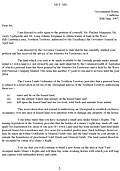A petition to the Governor-General
Frank Hardy cast about for a strategy to bring the plight of these pastoral workers to public attention. He learned that section 112 of the Crown Land Ordinance allowed for the Governor-General to grant a lease to Aboriginal people over land with which they were traditionally associated. This seemed to imply some recognition of Aboriginal attachment to traditional lands. Given that the Gurindji were squatting on land which they regarded as theirs before the Vesteys arrived with their cattle and horses, Hardy was sufficiently encouraged to draft a petition to the Governor-General. Drawn up on behalf of Vincent Lingiari, Pincher Manguari, Gerry Ngalgardji and Long-John Kitgnaari, it began:
We, the leaders of the Gurindji people, write to you about our earnest desire to regain tenure of our tribal lands in the Wave Hill-Limbunya area of the Northern Territory, of which we were dispossessed in time past. [1]
Petition to Lord Casey, Governor-General of Australia from four Gurindji spokesmen, April 1967
National Library of Australia, Frank Hardy Papers, 4887/73/6
They requested a lease of 500 square miles to be run cooperatively as a mining lease and cattle station. [2] The fact that the request concerned leased rather than Crown land, added another legal dimension to the land question.
A moral claim to land
In August 1967, the Federal Council for the Advancement of Aborigines and Torres Strait Islanders (FCAATSI) wrote to the Prime Minister, Harold Holt, supporting the petition by the Gurindji for a return of their tribal lands. A press statement in September, couched not in the language of industrial dispute, but in the new language of land rights, pledged support for 'the possible legal action to establish their rights to their traditional lands and sacred places'. [3] The argument had changed. It no longer lay within the boundaries laid out by the Arbitration and Conciliation Commission and designed to ensure justice in the Australian workplace. It had moved into territory without precedent in Australia. The Gurindji petition simply stated, 'we feel that morally the land is ours and should be returned to us'. [4]
The Governor-General's reply was about laws, not morals.
Governor-General's response to the Gurindji petition, June 1967
National Archives of Australia, Darwin
Download Governor-General's response to the Gurindji petition, June 1967 [PDF 12kb]
As a result of the Gurindji claim, the debate about Indigenous rights to land was no longer limited to Aboriginal reserves such as Yirrkala or Lake Tyers. Cabinet, however, rejected this interpretation and the Governor-General refused the request set out in the petition.
Related resources
People
Vincent Lingiari
Pincher Manguari
Organisation
Federal Council for the Advancement of Aborigines and Torres Strait Islanders
Footnotes
1 Gurindji petition to Lord Casey, Governor General, 19 April 1967, National Archives of Australia, Darwin.
2 Gurindji petition to Lord Casey, Governor General, 19 April 1967, National Archives of Australia, Darwin.
3 Minutes of FCAATSI executive meeting, 23-24 September 1967, Barrie Pittock personal papers.
4 Gurindji Petition to Lord Casey, Governor General, 19 April 1967, National Archives of Australia, Darwin.
384130
- 384081
- 384114
- 384130
- 384175
- 384189

